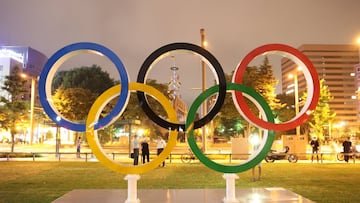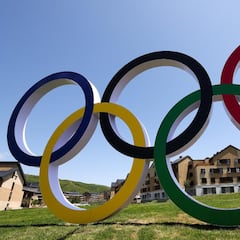Which color represents each continent in the Olympics rings?
The five interlocking rings of the Olympics represent the five parts of the world that compete in the Games, able to reproduce the colors of every nation.

The Olympic flag with its five interlocking rings dates back to 1913, created by Baron de Coubertin, the father of the modern Olympics. It would have to wait until after World War I to make its debut, hoisted over the 1920 Summer Olympics in Antwerp, Belgium.
The five rings represent the five continents of the world that participate in “the fruitful rivalries” of the Olympic Games. The colors - blue, yellow, black, green and red – stand out against the white background. The six colors can be combined in any number of ways to reproduce the flag of every country without exception.
Also see:
- Tokyo Olympics 2021: competition schedule
- Who are the oldest and youngest athletes at the Olympic Games?
- Which city has hosted the most Olympics?
- Are Olympic athletes vaccinated?
"This, truly, is an international emblem"
Today, it is said that each of the five colors represents a specific continent but doesn’t appear to have been Coubertin intention. “This design is symbolic; it represents the five continents of the world, united by Olympism, while the six colours are those that appear on all the national flags of the world at the present time,” Coubertin stated according to the Olympic Museum.
Although Coubertin might not have had a specific color in mind for each continent his intention was that the five rings do represent the five continents: African, American, Asia, Europe and Oceania. The idea for the symbol came after the 1912 Olympic Games in Stockholm, Sweden when around 2,400 athletes representing 28 nations from all the continents competed for the first time since the modern Olympic Games were resurrected in 1896.
In commemoration of the Tokyo Games, which begin Friday, land artist Dario Gambarin ploughed a depiction of the gate of Tokyo’s Meiji Jingu Shinto shrine and the five Olympic rings into an Italian cropfield. pic.twitter.com/iBPWvIePUJ
— CBS News (@CBSNews) July 20, 2021
The modern association of each color with a continent dates back to the 1950 edition of the IOC’s "Green Booklet" in which it stated that “These rings represent the five continents, blue for Europe, yellow for Asia, black for Africa, green for Australia and red for America.” This was retracted the following year, but once again the association was made in the logo of the Association of National Olympic Committees when it placed the logo of each of its five continental associations inside the ring of the corresponding color.
The universality of Olympism
Related stories
Coubertin was trying to create symbolism of unity and universality of Olympism by making the rings equal in formation and interlacing. It is meant to embody a unified international world of equals representing the core values of Olympism: excellence, friendship and respect. Also the meeting of athletes from around the world to compete for the sake of competing.
“The most important thing in life is not the triumph, but the fight; the essential thing is not to have won, but to have fought well,” states the Olympic creed.


